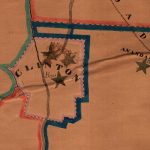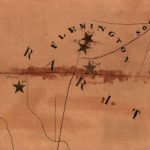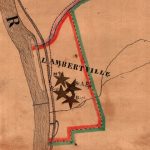Collection Gems: December 2020
Authored by: John Allen, johninretirement@gmail.com
The largest map in the Society’s Map Collection, Map 22 (93”x80.5”) is the “Sunday School Map of Hunterdon County” (Figure 1). It has no date but file notes suggest a range of dates from 1872 to 1898. It shows all Christian church locations with denomination, of all churches in the County… all, that is except Catholic Churches. Before you think there were no Catholic churches in the County, I give you Figures 2, 3, and 4. Figure 2 illustrated three churches in Clinton (and one in Annandale): Methodist Episcopal, Presbyterian, and Baptist Churches in Clinton, and a Unitarian (likely the Annadale Reformed) Church in Annandale. Omitted was the Immaculate Conception Church in Clinton (established in 1864). Figure 3 shows Flemington’s Presbyterian, Methodist Episcopal and Baptist Churches, but omits Saint Magdalen de Pazzi (established in 1843). Lastly, Figure 4 shows the same denominations plus Saint Andrew’s Episcopal Church – which relocated from Ringoes in 1845 – but omits Saint John the Evangelist, also established in 1843.
Recent political news has suggested Joe Biden will be influenced by the “radical Left”, and the Supreme Court’s Amy Coney Barrett is an “ultra-conservative”. But both are Roman Catholic. How is it that the full political spectrum is occupied (in some views) by Catholics?
It was only a generation ago that John F. Kennedy was being tarred as someone who, as a Catholic President, would take orders from The Vatican instead of the American people. His Republican opponent Richard M. Nixon’s campaign benefitted from the involvement of two prominent Protestant spokesmen, Billy Graham and Norman Vincent Peale, warning that the Pope would call the shots through a Kennedy White House. As a result, many evangelical groups were mobilized. Peale was challenged by the media for his anti-Catholicism and retreated, denying his involvement. Graham apparently “stayed the course”. In the end, Catholics gave Kennedy from 75 to 80 percent of their votes and, when combined with other Democratic voters, sent him to the Presidency.
And the prior generation saw New York’s Al Smith, the Democratic candidate for President, denounced by prominent evangelical Billy Sunday because of Smith’s alleged ties to the Papacy. In 1928, the Southern states were still a stronghold of Democratic (but non-Catholic) voters who did NOT turn out for Smith but, responding to anti-Catholic rhetoric and their strongly held Anglo-Saxon Americanism, voted for Republican Herbert Hoover. Unsurprisingly, the rise of the Ku Klux Klan in early 20th Century produced a large base of individuals who were vehemently anti-Catholic, among other groups. Unfortunately for Smith, the largest delegate bloc attending the Democratic National Convention was composed of Klansmen. A search of “newspapers.com” for 1922 reveals a substantial number of articles pertaining to the presidential race… and its religious considerations.
I wasn’t sure how to end this article, but my bride sent me a link to a wonderful article about St. Hubert’s Chapel, an 1886 gem on an island in Lake Kinnelon, Morris County. It was built by tobacco tycoon Francis S. Kinney for his devout Catholic wife Mary who had to travel 7 miles to the nearest Church. The chapel was the first interior space built by Louis C. Tiffany, so you know it was pretty spectacular (and expensive)! Francis died in 1908 and is buried in Woodlawn Cemetery in The Bronx, with lots of famous people from many faiths, demonstrating that – then as now – money is more important than religious beliefs when it comes to business!




